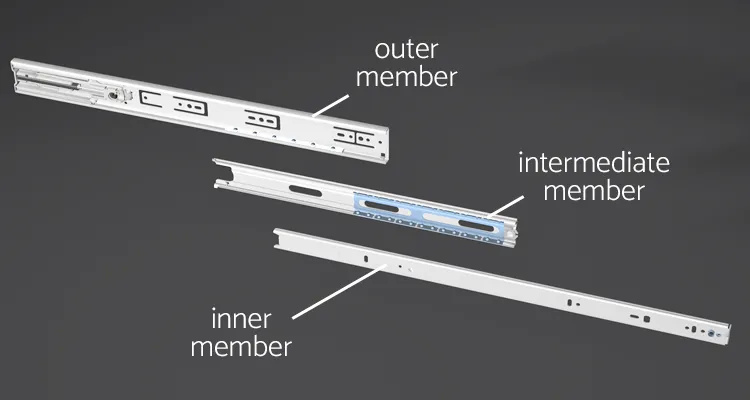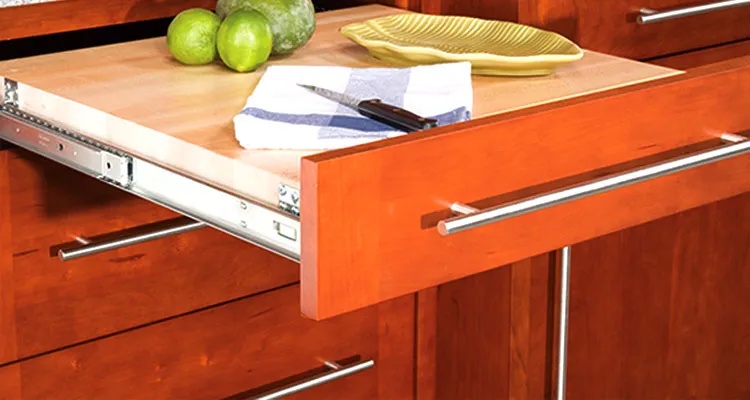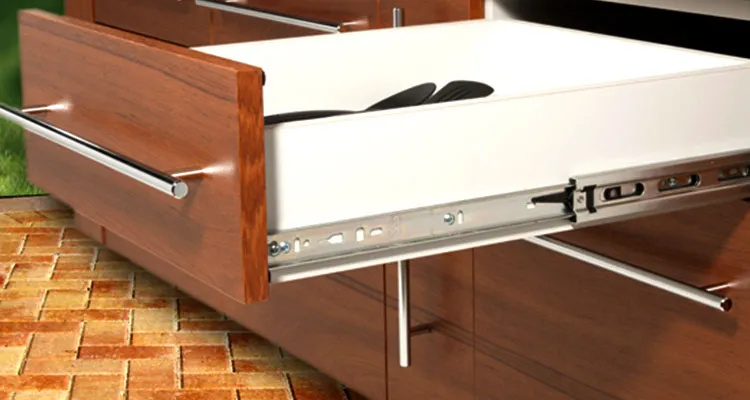What is a Drawer Slide and How Do I Choose the Right One?
- Choosing the right drawer slide can be the difference between a satisfied purchase and years of headaches.
- Most slides come in one of two arrangements, side mount, and undermount.
- Determining how much load-capacity you need is key in choosing the right slide.
- Other important factors to consider include, type of locking system, which drawer disconnect method you prefer, and if you are looking for any special features.
A good drawer slide means the difference of years of headaches versus years of convenience. Unless you have a lifetime’s supply of aspirin, you want the latter. But what goes into a good drawer slide and how do you figure the right one for your need?
Here’s a brief guide to help you understand the basics of a drawer slide and how to choose the right one for your application.
The Basics
Accuride manufactures ball bearing slides. These slides feature lubricated bearings that move drawers and the like in a linear direction, allowing smooth opening and closing action. The bearings, secured within metal ball retainers, fit between the members.
A simple drawer slide has two members: a drawer (inner) member that attaches to the side of a drawer box, and a cabinet (outer) member that attaches to the cabinet’s inner wall surface, within the drawer opening. Only one of the slide members (drawer) moves when opening a drawer.

A more complex slide structure will include three members, with an intermediate member located between the cabinet and drawer members. Only the drawer and intermediate members move; while the cabinet member remains fixed to its location within the cabinet structure.
Additionally, slides can come in two arrangements: side mount and undermount. Most Accuride drawer slides are side mount, meaning they’re mounted on the side of the drawer and within the cabinet structure. A undermount slide, such as the 3135EC Eclipse, mounts in a position that allows a specially designed drawer to sit on top of the suspension, unlike a side mount slide. An undermount slide is often used where it’s desirable to conceal the drawer slide components from view.
Ball bearing drawer slides are also known as rails, runners, and sliders, but they are not the same as glides. A glide uses thin rails on both mounting surfaces, and include plastic wheels on the drawer side allowing movement. Glides are often found on discount furniture; while inexpensive, their movement is much less smooth and the rails are prone to misalignment.
Lengths and Extensions
Accuride slides come in many lengths, from as little as 6 in. to as long as 60 in. Length refers to the total length of the slide assembly, when collapsed in the closed position.
How far a slide extends or moves, is called extension or travel. A simple slide that uses just two members, an inner and an outer, generally provides ¾ (or partial) travel. That means the moving drawer member travels at ¾, or 75%, of the slide’s length. The Accuride 2132 is an example of a ¾-travel slide, where an 18-in. slide has approximately 13 in. of travel. These types of slides are common in residential uses, such as in kitchen cabinetry, or in office furniture, where direct full access to the drawer’s contents is not desired.
Three-member slides have two moving components, the drawer and intermediate members. In combination, these members tend to extend either the full (100%) length of the drawer slide assembly or even beyond that. Those that exceed the length are called “over-travel” slides because they travel over 100% of the length of the drawer slide assembly. Full-extension slides, such as the Accuride 3832E Classic, are useful if you need easy access to contents, as with kitchen utensil drawers, and point of sale trays. Over-travel slides, such as the Accuride 3834E, which has 1 in. of over-travel, are ideal when additional drawer access is needed, requiring the drawer to be opened beyond the front face of the cabinet.
There are also two-way travel slides, such as the Accuride 0363, which can extend the full-length, of the slide, in either direction. These are useful for kitchen islands or entertainment bars, where direct access is needed on either side of the unit.
With that said, let’s look at some factors that can help you choose the right slide for your application.
Load Capacities
Determine how much weight your application is likely to see when in use. Accuride slides’ load capacities fall into three ranges: light-, medium-, and heavy-duty. A light-duty slide, such as the Accuride 2132, handles loads up to 75 lbs. Light-duty applications often include kitchen and office drawers. A medium-duty slide, such as the Accuride 3832E Classic, handles loads up to 100 lbs., while an Accuride 4032 is a rated up to 150 lbs. Medium-duty applications include larger kitchen drawers and office furniture. Load capacities for some of Accuride’s heavy-duty drawer slides can reach up to 1,300 lbs. The Accuride 9301E is an example of a heavy-duty slide, which has a load rating of up to 600 lbs. Heavy-duty applications include pull-out trays on emergency or recreational vehicles, ATM machines, and utility/service trucks.
 |  |
Disconnect versus Non-Disconnect*
Decide if you want your drawer to be removable from the cabinet structure. If so, choose a slide with a disconnect feature that lets you separate the drawer member from the cabinet, or intermediate member, allowing the removal of the drawer (to clean for example). There are slides with rail disconnect features (such as the Accuride 4032), which allow rails that are attached to the sides of drawers, to be released and lifted off the corresponding drawer members.
A disconnect feature is useful for furniture manufacturers with multiple assembly lines. One line may assemble hardware to drawers, while another may assemble hardware to cabinets. With a disconnect slide, manufacturers can simply mount the separate members in the assembly phases and then join them together in the final stage. Connecting a drawer member with a cabinet member can be as simple as align, engage and push closed.
Usually, you want to avoid a disconnect option with heavy-duty applications, such as those utilizing an Accuride 9301E. With most heavy-duty applications, it’s impractical (and a safety concern) to remove a fully loaded drawer. Regardless of whether you use a disconnect feature with light- or medium-duty slide, consider whether you can safely handle the drawer and its contents before disconnecting the members.
* Read more about Accuride disconnect features from our first installment of Slideology:101 – The Art of Disconnect
Locks & Detents
Do you want your drawer to be secured in position? In that case, you may want your slide to include a detent or a locking feature. There are two types of drawer slide detents: detent-in and detent-out.
A detent-in slide has an engagement feature formed on the drawer member and a rubber-like molding secured at the rear of the cabinet member. These two features cooperate to frictionally hold a closed drawer in that position, preventing the drawer from drifting open. You can overcome the detent with a pull on the drawer when opening.
A detent-out slide includes cooperating components that holds the slide in the fully extended position, until you are ready to retract the drawer or a working platform, such as a keyboard tray. Deactivating a detent-out slide requires a simple “bump” of the extended unit to release the engagement features before pushing it back inside the cabinet.
There are two types of drawer slide locking features: lock-in or lock-out. Both features include a latching mechanism that secures a drawer open or closed. You can disengage, or unlock, the drawer by pressing a latch or lever (depends on the model). Some slides are just lock-out equipped, while a slide such as the Accuride 9308E has both features, ideal for mobile applications such as emergency vehicles.
Special Features
Additionally, slides can come with features that make opening or closing a drawer more convenient. These include:
- Easy-Close
- Self-Close
- Touch Release
An Easy-Close slide includes a closing device, equipped with a damping cylinder, and cooperating springs that engages with the drawer member and assists the final inches of the drawer closing action. Easy-Close (sometimes-called Soft-Close) slides provide assurance that the drawer will close quietly and smoothly every time.
A Self-Close slide, also includes a closing device, with springs, but does not include a damping cylinder. The engagement of the drawer member is similar, and once engaged with the device, the drawer quickly closes at the last inches of closing distance. Self-close slides are noisier than Easy-Close slides, and sometimes are used as “stay-closed” devices for mobile cart applications.
A Touch Release slide allows opening of the drawer, without the need for a drawer pull. Activation of a Touch Release slide like the Accuride 3832ETR, is accomplished by simply pressing against the drawer front, which releases a spring activated device to “spring” the drawer out of the cabinet approximately 2 in. Closing is just a matter of pushing the drawer closed completely, which resets the device for the next opening activity.
Choice of Finish
Accuride slides come in three coated finishes placed over carbon steel slide members: zinc, black electroplate, or white electro-coat. Some slides utilize stainless steel or aluminum material as needed for specific applications. Zinc is most common plating finish for Accuride; it features an environmentally friendly base layer of zinc, with either a clear or a black chromate coating over the top. A clear zinc coating (the most common coating used by Accuride) resists moderate levels of corrosion, typically for slides used in non-corrosive environments, like office furniture. Electro-white (a paint) or black chromate-coated slides offer greater corrosion resistance that is eight-times that of clear zinc. Stainless steel and aluminum material slides offer even greater corrosion-resistant but are available only on select models.
Conclusion
This brief guide should shed some more light on what makes an Accuride slide and how it can best serve your needs. You can browse our vast selection of movement solutions at www.accuride.com.
Remember to follow us on social media channels at Facebook, Twitter, LinkedIn, Instagram and YouTube. Don’t forget to check out the latest from Meeka, our celebrity staffer and frequent Employee of the Quarter winner!
Related Posts
5 Project Plans with Accuride Slides
April 20th, 2020
What is Progressive Movement in a Slide?
April 6th, 2020
Has Your Drawer Slide Lost Its Smooth Movement?
April 6th, 2020